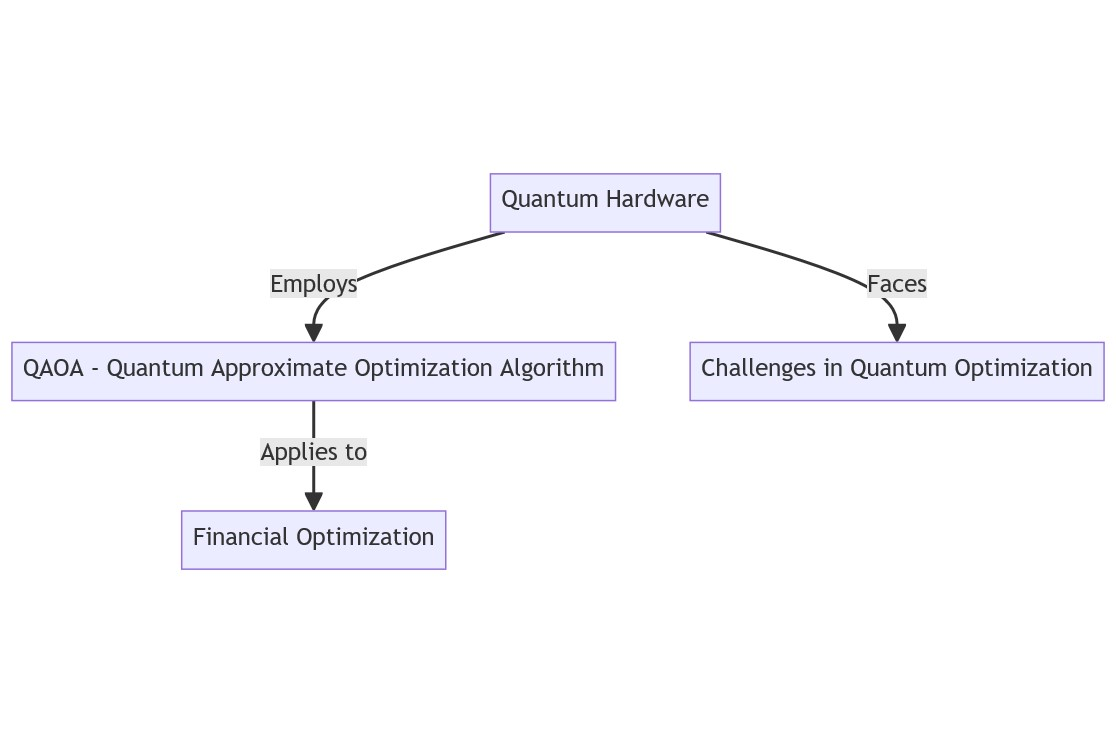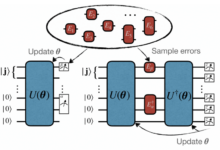Quantum AIs Potential in Logistics Optimization
Quantum AI’s potential in solving optimization problems in logistics is rapidly gaining attention. Classical computing struggles with the immense complexity of global supply chains, route planning, and warehouse management. Quantum algorithms, however, offer the promise of dramatically faster and more accurate solutions to these intricate problems. This exploration delves into how quantum computing could revolutionize the logistics industry, examining various quantum algorithms and their applications, while also acknowledging the existing technological challenges.
We’ll explore how quantum annealing can tackle vehicle routing problems, compare different quantum approaches for supply chain optimization, and even look at a hypothetical quantum algorithm for optimizing last-mile deliveries. Real-world examples and case studies will illustrate the current state of development and highlight potential future applications in diverse logistics sectors. Finally, we’ll discuss the hurdles and necessary research to fully realize the potential of quantum AI in this field.
Introduction to Quantum AI and Logistics Optimization
Logistics, the intricate dance of moving goods and resources, faces ever-increasing complexity. Classical computing, while powerful, struggles to keep pace with the demands of optimizing vast networks, intricate schedules, and unpredictable events. Quantum computing, however, offers a potential game-changer, promising to tackle these challenges with unprecedented speed and efficiency. This section explores the intersection of quantum AI and logistics optimization, highlighting the potential benefits and addressing current limitations.Quantum computing leverages the principles of quantum mechanics to perform calculations in ways impossible for classical computers.
Unlike classical bits representing 0 or 1, quantum bits (qubits) can exist in a superposition, representing 0 and 1 simultaneously. This, combined with phenomena like quantum entanglement, allows quantum computers to explore multiple possibilities concurrently, dramatically accelerating certain types of computations. This inherent parallelism is particularly valuable in tackling optimization problems, which often involve searching through a vast number of potential solutions.
Quantum Algorithms and Logistics Optimization
Quantum algorithms, specifically those designed for optimization problems, could revolutionize logistics. For instance, quantum annealing, a technique used in quantum computers like those produced by D-Wave, can efficiently find near-optimal solutions to complex combinatorial optimization problems. These problems are ubiquitous in logistics, encompassing route optimization, warehouse layout design, and supply chain management. Consider a delivery company managing thousands of packages across a large geographical area; a quantum algorithm could potentially determine the most efficient delivery routes far faster than any classical algorithm, minimizing fuel consumption and delivery times.
Similarly, optimizing the placement of items in a warehouse to minimize picking times, or predicting and mitigating supply chain disruptions, could significantly benefit from the power of quantum computation.
Limitations of Classical Computing in Logistics
Classical computers face significant limitations when dealing with the scale and complexity of modern logistics. The computational cost of exploring all possible solutions for large-scale optimization problems quickly becomes prohibitive, leading to suboptimal solutions or impractically long computation times. For example, determining the optimal route for a fleet of vehicles delivering to hundreds of locations using traditional algorithms can be computationally expensive and time-consuming, even with sophisticated heuristics.
The inherent limitations of classical algorithms in handling uncertainty and dynamic changes in real-time further exacerbate these issues. The unpredictable nature of traffic, weather, and unforeseen events requires adaptive solutions, which classical systems struggle to provide efficiently. Furthermore, the sheer volume of data generated by modern logistics operations – encompassing sensor data, GPS tracking, and customer orders – overwhelms the capacity of many classical systems for real-time analysis and decision-making.
Quantum Algorithms for Logistics Optimization: Quantum AI’s Potential In Solving Optimization Problems In Logistics
Quantum computing offers the potential to revolutionize logistics optimization by tackling complex problems that are intractable for classical computers. The inherent parallelism and superposition properties of quantum mechanics allow for exploring a vast solution space more efficiently, leading to potentially significant improvements in routing, scheduling, and resource allocation. This section will delve into specific quantum algorithms and their applicability to various logistics challenges.
Quantum Annealing for Vehicle Routing Problems
Quantum annealing, a type of quantum computation implemented on specialized hardware like those produced by D-Wave Systems, shows promise for solving vehicle routing problems (VRPs). VRPs involve finding the optimal routes for a fleet of vehicles to serve a set of customers, minimizing factors like total distance traveled or delivery time. Quantum annealing excels at finding the global minimum of a cost function, which directly translates to finding the optimal route in a VRP.
By encoding the VRP constraints and costs into a suitable Ising Hamiltonian, a quantum annealer can efficiently explore the solution space and identify near-optimal solutions, especially for problems with a large number of vehicles and customers where classical algorithms struggle. For instance, a scenario involving the delivery of packages across a large metropolitan area, with time windows and traffic considerations, could benefit significantly from the speed and potential for better solutions offered by quantum annealing.
The problem is formulated as an optimization problem where the cost function represents the total distance and potential penalties for violating time windows. The quantum annealer then finds the configuration of vehicle routes that minimizes this cost function.
Comparison of Quantum Annealing and Quantum Gate-based Approaches
Quantum annealing and quantum gate-based approaches represent distinct methods for quantum computation, each with strengths and weaknesses in the context of supply chain management. Quantum annealing, as discussed above, is particularly well-suited for optimization problems where finding the global minimum of a cost function is the primary goal. However, its applicability is limited to problems that can be effectively mapped onto a quadratic unconstrained binary optimization (QUBO) problem.
Quantum gate-based algorithms, on the other hand, offer greater flexibility and can tackle a wider range of problems. Algorithms like Quantum Approximate Optimization Algorithm (QAOA) are particularly promising for supply chain optimization. While QAOA might not guarantee finding the absolute global optimum, it can often find high-quality solutions faster than classical algorithms for complex problems. The choice between these approaches depends heavily on the specific problem structure and the available quantum hardware.
For simpler optimization problems in supply chain management, quantum annealing might be sufficient. For more complex scenarios involving intricate constraints and dependencies, quantum gate-based algorithms like QAOA offer a more powerful and adaptable solution.
Quantum Approximate Optimization Algorithm (QAOA) for Warehouse Optimization, Quantum AI’s potential in solving optimization problems in logistics
Warehouse optimization is a critical aspect of supply chain management, aiming to maximize efficiency in storage, picking, and packing processes. QAOA, a variational quantum algorithm, is well-suited for tackling such optimization problems. QAOA works by iteratively improving an approximate solution to a given optimization problem. In the context of warehouse optimization, this might involve optimizing the placement of goods in the warehouse to minimize travel distances for order picking or optimizing the routing of automated guided vehicles (AGVs) within the warehouse.
The problem is formulated as a cost function that considers factors such as travel time, storage costs, and order fulfillment time. QAOA then iteratively refines the solution by adjusting parameters to minimize this cost function. A real-world example could be a large e-commerce fulfillment center where optimizing the placement of frequently ordered items closer to the packing stations significantly reduces order fulfillment time.
QAOA can potentially find better solutions compared to classical approaches, especially when dealing with a high-dimensional solution space and numerous constraints.
Hypothetical Quantum Algorithm for Optimizing Last-Mile Delivery Routes
A hypothetical quantum algorithm for optimizing last-mile delivery routes could leverage QAOA or a similar variational algorithm. The algorithm would take as input data on delivery locations, delivery time windows, traffic conditions (obtained from real-time traffic data feeds), and vehicle capacities. The cost function would incorporate factors such as total travel time, distance, fuel consumption, and penalties for late deliveries.
The algorithm would then iteratively adjust the delivery routes to minimize the overall cost function. The algorithm could incorporate techniques like quantum machine learning to predict traffic patterns and dynamically adjust routes in response to changing conditions. For example, if an unexpected traffic jam occurs, the algorithm could reroute deliveries to avoid delays, leading to more efficient and timely deliveries.
The quantum speedup could be particularly significant in large-scale last-mile delivery networks where the number of possible routes is astronomically large.
Case Studies and Applications
While still in its early stages, the application of Quantum AI in logistics optimization is showing promising results. Several companies are actively exploring its potential to solve complex problems that are intractable for classical computers. The following sections will highlight some real-world examples and explore potential future applications across various logistics sectors.
Real-World Examples of Quantum AI in Logistics Optimization
Several companies are beginning to investigate the use of quantum algorithms to improve their logistics operations. The following table summarizes some preliminary findings. Note that the field is rapidly evolving, and results are often preliminary and subject to change.
| Company | Application Area | Algorithm Used | Preliminary Results |
|---|---|---|---|
| IBM (in collaboration with various logistics partners) | Supply chain optimization, specifically focusing on route planning and warehouse optimization. | Variational Quantum Eigensolver (VQE), Quantum Approximate Optimization Algorithm (QAOA) | Improved route efficiency in simulations; early stage testing showing potential for reduced transportation costs and delivery times. Further research and development are ongoing. |
| DHL | Last-mile delivery optimization | Quantum annealing algorithms (e.g., using D-Wave systems) | Exploring the use of quantum computing to optimize delivery routes, considering factors like traffic, weather, and delivery time windows. Results are still under development and not yet publicly released in detail. |
| Volkswagen | Supply chain optimization and vehicle routing | Quantum-inspired algorithms (classical algorithms leveraging quantum principles) | Improved efficiency in simulations; focused on reducing logistics costs and improving delivery times in their complex global supply chain. Specific results are largely confidential. |
| Google (in collaboration with logistics companies) | Warehouse optimization and inventory management | Various quantum algorithms are being explored. | Early-stage research focusing on optimizing warehouse layout and improving inventory management to reduce storage costs and improve efficiency. Publicly available results are limited. |
Potential Applications Across Logistics Sectors
Quantum AI’s potential extends across various logistics sectors. In transportation, it can optimize routing for fleets of vehicles, considering real-time traffic, weather conditions, and delivery deadlines. In warehousing, it can improve the efficiency of storage and retrieval processes, minimizing space usage and maximizing throughput. Supply chain management can benefit from optimized inventory levels, reduced lead times, and improved risk management through predictive analytics enhanced by quantum computing.
Optimizing Delivery Networks for E-commerce
Consider a large e-commerce company with a vast delivery network spanning multiple regions and warehouses. Quantum AI could significantly optimize its delivery operations by solving the vehicle routing problem (VRP) more efficiently than classical algorithms. The VRP involves finding the optimal routes for a fleet of delivery vehicles to serve a set of customers, minimizing total travel distance and delivery time while considering constraints such as vehicle capacity, delivery time windows, and traffic conditions.
A quantum algorithm could handle the exponentially increasing complexity of the VRP as the number of customers and vehicles grows, leading to significant cost savings and improved customer satisfaction through faster and more reliable deliveries. This optimization would involve considering real-time data, such as traffic patterns and weather conditions, to dynamically adjust routes and optimize delivery schedules.
Challenges and Future Directions
The application of Quantum AI to logistics optimization, while promising, faces significant hurdles. Current limitations in quantum computing hardware and software, coupled with the complexity of real-world logistics problems, present considerable challenges to widespread adoption. Overcoming these obstacles requires a multi-faceted approach involving advancements in both quantum technologies and the development of sophisticated algorithms tailored to the specific needs of the logistics industry.The computational resources needed to tackle large-scale logistics optimization problems using Quantum AI are substantial.
Current quantum computers, even the most advanced, possess a limited number of qubits and suffer from high error rates. Solving complex optimization problems involving thousands or millions of variables and constraints, typical in global supply chain management, requires significantly more powerful and stable quantum computers than are currently available. This necessitates substantial investment in quantum hardware development and error correction techniques.
Computational Resource Requirements
Large-scale logistics optimization problems, such as global supply chain management, often involve millions of variables and constraints. Solving these problems using classical algorithms is computationally expensive and time-consuming. While quantum algorithms offer the potential for exponential speedups, current quantum computers lack the scale and stability to handle problems of this magnitude. For example, simulating the complex interactions of a global supply chain with thousands of nodes (warehouses, factories, distribution centers) and millions of transportation links would demand a quantum computer with significantly more qubits and lower error rates than are currently achievable.
Furthermore, the development of efficient quantum algorithms capable of effectively utilizing these resources is also crucial. The sheer amount of data involved, including real-time traffic updates, weather patterns, and fluctuating demand, necessitates sophisticated data preprocessing and integration techniques.
Technological Hurdles and Limitations
Several technological barriers currently hinder the application of Quantum AI in real-world logistics. These include:
- Qubit coherence time: Maintaining the quantum state of qubits for sufficiently long periods is crucial for performing complex computations. Current quantum computers have relatively short coherence times, limiting the complexity of problems they can solve.
- Error rates: Quantum computations are susceptible to errors. High error rates in current quantum computers lead to unreliable results and require sophisticated error correction techniques, which themselves consume significant computational resources.
- Scalability: Building large-scale, fault-tolerant quantum computers is a significant engineering challenge. Increasing the number of qubits while maintaining low error rates is a key focus of ongoing research.
- Algorithm development: Developing efficient and robust quantum algorithms specifically designed for logistics optimization problems is an active area of research. Many existing quantum algorithms are still in their early stages of development and may not be directly applicable to real-world logistics scenarios.
Roadmap for Future Development and Implementation
A phased approach is necessary for the successful integration of Quantum AI into the logistics industry. This involves:
- Continued investment in quantum hardware development: Focus on increasing the number of qubits, improving qubit coherence times, and reducing error rates.
- Development of specialized quantum algorithms: Creating algorithms tailored to specific logistics optimization problems, such as vehicle routing, warehouse optimization, and supply chain network design.
- Hybrid classical-quantum approaches: Leveraging the strengths of both classical and quantum computers by combining them in a hybrid approach. Classical computers can handle the preprocessing and post-processing of data, while quantum computers can solve the computationally intensive optimization subproblems.
- Development of robust error mitigation and correction techniques: Improving the reliability of quantum computations by developing and implementing effective error mitigation and correction strategies.
- Collaboration between academia, industry, and government: Fostering collaboration to accelerate the development and deployment of Quantum AI in logistics.
Potential Areas of Research
Significant advancements are needed to fully realize the potential of Quantum AI in logistics. Key areas of research include:
- Developing more efficient quantum algorithms for specific logistics problems, such as the Traveling Salesperson Problem (TSP) and the Vehicle Routing Problem (VRP), which are computationally challenging even for classical computers.
- Improving quantum error correction techniques to reduce the impact of noise on quantum computations.
- Exploring hybrid classical-quantum algorithms that combine the strengths of both classical and quantum approaches.
- Developing new methods for efficiently encoding and processing large datasets on quantum computers.
- Investigating the use of quantum machine learning techniques for improving the accuracy and efficiency of logistics optimization models.
- Developing standardized benchmarks and metrics for evaluating the performance of quantum algorithms for logistics optimization.
Illustrative Examples
Let’s consider a real-world scenario to understand how quantum and classical approaches to logistics optimization differ. We’ll focus on a global supply chain, highlighting the strengths and weaknesses of each method. The complexities involved will make the advantages of a quantum approach more apparent.A global supply chain, even a simplified one, involves numerous variables: sourcing raw materials from various locations, manufacturing in multiple factories, distributing products across continents, managing inventory at warehouses, and finally, delivering to customers.
Optimizing this network to minimize costs, delivery times, and carbon footprint is a monumental task.
Global Supply Chain Optimization: Quantum vs. Classical
Imagine a multinational company manufacturing and distributing electronics. This company has factories in Asia, Europe, and North America, sourcing components from diverse suppliers worldwide. They need to optimize the transportation of these components to factories, the distribution of finished products to warehouses across the globe, and finally, the delivery to customers.A classical approach might use established optimization techniques like linear programming or heuristics.
These methods would involve constructing a massive mathematical model representing the entire supply chain, incorporating factors such as transportation costs, lead times, warehouse capacities, and customer demand. Solving this model, even with sophisticated algorithms and powerful computers, can be computationally expensive and time-consuming, often resulting in suboptimal solutions, especially for extremely large and complex networks. The process would involve iterative adjustments and approximations, potentially missing ideal solutions due to the sheer complexity of the problem.A quantum approach, on the other hand, could leverage algorithms like Quantum Approximate Optimization Algorithm (QAOA) or Variational Quantum Eigensolver (VQE).
These algorithms can explore the solution space more efficiently than classical methods, potentially finding better solutions in less time. While the exact implementation would depend on the specific quantum hardware and algorithm used, the key difference lies in the ability of quantum computers to explore multiple possibilities simultaneously through superposition and entanglement, leading to faster convergence to near-optimal solutions.
| Problem Aspect | Classical Approach | Quantum Approach | Performance Comparison |
|---|---|---|---|
| Problem Representation | Mathematical model (e.g., linear program) | Quantum Hamiltonian representing the optimization problem | Quantum representation may be more compact and efficient for certain problem structures. |
| Solution Method | Iterative algorithms (e.g., simplex, interior-point methods), heuristics | Quantum algorithms (e.g., QAOA, VQE) exploiting superposition and entanglement | Quantum algorithms offer the potential for exponential speedup for specific classes of problems. |
| Computational Cost | High computational cost, scaling poorly with problem size | Potentially lower computational cost, especially for large-scale problems | Quantum approaches may significantly reduce computation time, leading to faster solutions. |
| Solution Quality | Often suboptimal, especially for large and complex problems | Potential for finding better solutions closer to the global optimum | Quantum algorithms may improve solution quality, leading to cost savings and increased efficiency. |
| Scalability | Limited scalability due to computational complexity | Potential for better scalability with advancements in quantum hardware | Quantum computing offers a path towards handling increasingly complex logistics problems. |
Closure

Source: insights2techinfo.com
The integration of Quantum AI into logistics promises a significant leap forward in efficiency and optimization. While technological hurdles remain, the potential benefits—faster route planning, optimized warehousing, and improved supply chain management—are too significant to ignore. Continued research and development, coupled with collaborative efforts across industry and academia, will be crucial in unlocking the full potential of quantum computing to reshape the future of logistics and deliver goods more efficiently and cost-effectively than ever before.
The journey is just beginning, but the destination – a more streamlined and optimized logistics landscape – is well worth the effort.
Commonly Asked Questions
What are the main types of quantum algorithms relevant to logistics?
Quantum Annealing, Quantum Gate-based methods, and the Quantum Approximate Optimization Algorithm (QAOA) are key algorithms being explored for logistics optimization.
How much will quantum computers cost to implement for logistics companies?
The cost is currently very high, limiting access to large companies and research institutions. However, costs are expected to decrease as the technology matures.
What are the ethical considerations of using Quantum AI in logistics?
Concerns include data privacy, potential job displacement due to automation, and the need for fair and transparent algorithms to avoid bias in decision-making.
When can we expect widespread adoption of Quantum AI in logistics?
Widespread adoption is still years away, depending on technological advancements, cost reductions, and the development of user-friendly software and interfaces. Specific applications may see earlier adoption than others.
Are there any existing companies actively using quantum computing for logistics?
While widespread adoption is limited, several companies are exploring the use of quantum computing for logistics optimization in research and development projects. Specific examples would need further research to identify publicly available information.









